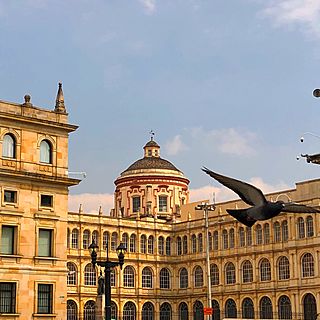Plateresque facts for kids


Plateresque is a special art style, mostly seen in buildings. Its name means "in the way of a silversmith" because plata is the Spanish word for silver. This style started in Spain and its territories in the late 1400s. It mixed older styles like Gothic and Mudéjar with new ideas from the Renaissance.
Imagine a building that looks like it's covered in fancy jewelry! That's Plateresque. It often has shields, pointy towers, and columns that look like those from ancient Rome. The style became very popular during the time of Charles V, Holy Roman Emperor. You can see many amazing examples in cities like Salamanca, León, Burgos, and Santiago de Compostela in Spain. It also spread to places like Mexico (which was then called New Spain) and Bogotá in South America.
Many experts think Plateresque is a type of Renaissance style. Others believe it's its own unique style, sometimes called Protorenaissance or First Renaissance. No matter what it's called, it's a beautiful blend of different art forms.
Plateresque buildings are known for their very detailed and decorated fronts. These decorations often include flowers, fancy lamps, garlands, and even imaginary creatures. Even though the decorations were new, the basic shape of the buildings often stayed true to the Gothic style. In New Spain, Plateresque mixed with local Native American art, creating a truly unique look.
In the 1800s, people started to love old styles again. Plateresque was revived under a new name: the Monterrey Style.
Contents
What Does Plateresque Mean?
The word Plateresque comes from the work of silversmiths. These artists made beautiful, detailed items out of silver. The style got its name because the buildings looked as finely crafted and decorated as a silversmith's work. Diego Ortiz de Zúñiga first used the term in the 1600s to describe a chapel in the Cathedral of Seville.
A Unique Spanish Style
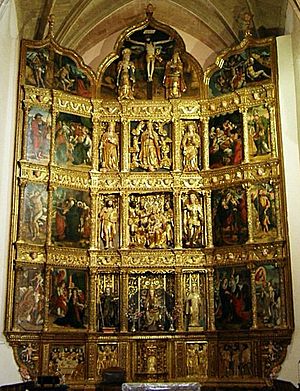
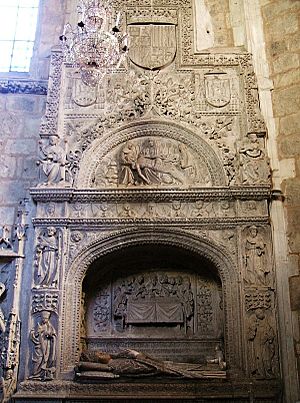
Plateresque is often seen as a style unique to Spain and its lands from the 1400s to the 1600s. However, some art experts, like Camón Aznar and Rosenthal, have pointed out that it's a mix of different ideas. It combines Gothic, Muslim, and Renaissance elements. They even found similar styles in other European countries, like France and Portugal.
This shows that Plateresque was a style that appeared during a time of big changes in art. It was a way for Spanish architects to add lots of decoration to buildings. This was especially true as Spain became a powerful empire after the Reconquista and started exploring the Americas. The people wanted grand buildings to show off their new power and wealth.
Features of Plateresque Architecture
Spanish Plateresque Buildings
Plateresque building fronts look like giant altarpieces. They are covered in decorations, just like a goldsmith would decorate a piece of jewelry. You'll see lots of plant designs, but also medallions, family symbols (heraldry), and animal figures. Artists used many materials, sometimes even gold on the tops of walls.
Over time, more Italian design ideas were added. These included rough stone walls (rustications), classical capitals on columns, Roman arches, and funny, strange figures called grotesques.
These decorations weren't just pretty; they had meaning. For example, laurel leaves and military shields were often placed on the homes of soldiers. Stories from Greek and Roman myths were used to show important ideas. So, the decorations helped spread new Renaissance thoughts.
Plateresque also brought new ways of building spaces. For instance, open-box stairs became popular. However, the basic layout of the buildings often stayed similar to older Gothic designs.
American Plateresque Buildings

When the Spanish arrived in America, especially in what is now Mexico, they brought the Plateresque style with them. Local cultures already had their own rich art traditions. The European Plateresque style mixed with these Native American influences. This blend led to a new style that later became known as American Baroque.
History of Plateresque
The Plateresque style followed the Isabelline style. This earlier style also mixed Italian and Spanish ideas to create detailed decorations on Gothic buildings. Plateresque kept Gothic shapes as its base until about 1530. After that, it started to include more Renaissance ideas in the overall design.
In 1563, a new building called the monastery of San Lorenzo de El Escorial began construction. This marked a shift towards a purer Renaissance style in Spain, led by architect Juan de Herrera. This change meant the Plateresque style became less popular in Spain. However, it continued to thrive in Mexico, even leading to a new version called Neo-Plateresque in the 1700s.
Whether you see it as a separate style or not, Plateresque clearly shows the artistic journey from the Gothic period to the Renaissance.
Isabelline Style (1400s)
In the 1400s, a trend for very ornate decoration grew in Spain. It mixed ideas from Flemish, Islamic, and Spanish art. This style was called Isabelline Gothic because much of it was built for Isabella I of Castile. These fancy decorations didn't change the main structure of the buildings. A similar style, called Manueline, developed in Portugal around the same time.
Plateresque Gothic (Late 1400s–1530)
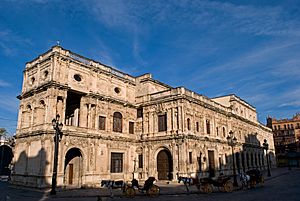
In the late 1400s, Spanish artists started to decorate Gothic buildings with lots of new, flowery designs. They copied Renaissance decorations, like grotesques, but didn't fully understand the new ideas behind them. So, they just added these new elements on top of older medieval shapes.
Many Plateresque buildings were already built in the Gothic style. Artists simply added layers of Renaissance decoration, especially around windows and doors. This idea of adding new Renaissance elements to older medieval forms was also seen in Spanish painting and sculpture of the time.
Plateresque Renaissance (1530–1560)
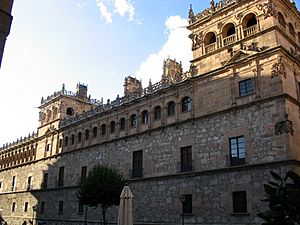
During this period, Renaissance ideas became stronger in Spain. The decorations were still very detailed, but they now fit with the overall design of Renaissance buildings. This period ended around 1563, when the construction of the monastery of El Escorial began, bringing a more refined Renaissance style.
Plateresque Revival: Monterrey Style (1800s & 1900s)
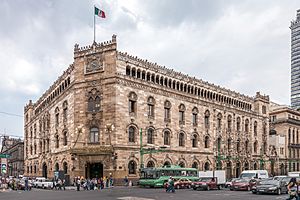
In the 1800s, the Plateresque style made a comeback. It was called the Monterrey style, named after the beautiful Palace of Monterrey in Salamanca, built in 1539. Many architects admired this palace and copied its style across Spain. This led to a new "revival" style called Neo-Plateresque.
This style continued into the early 1900s. You can see examples on the Gran Vía in Madrid. In Mexico, a different version of Neo-Plateresque appeared in the 1700s and spread to the Southwestern United States. This is not the same as the Monterrey style from Spain.
Famous Plateresque Examples
Architects and Artists
- Early Plateresque:
* Diego de Alcázar * Alonso de Covarrubias * Martín de Gainza * Rodrigo Gil de Hontañón * Gil de Siloé * Andrés de Vandelvira * Diego de Riaño * Diego Siloe * Vasco de la Zarza
- Neo-Plateresque:
* Eduardo Adaro Magro * José López Sallaberry
Buildings and Works
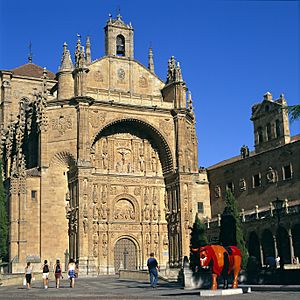
- The front of the Convent of San Marcos (León).
- The Tower of Guadramiro (Salamanca).
- The front of the University of Salamanca.
- The front of the Basilica of Saint Mary Major of Pontevedra.
- The Hospital of the Catholic Monarchs of Santiago de Compostela.
- The front of the New Cathedral of Salamanca.
- The front of the Convent of San Esteban of Salamanca.
- The cloister of the Convent of las Dueñas of Salamanca.
- The Palace of Monterrey in Salamanca.
- The front of the Colegio Mayor de San Ildefonso, at the University of Alcalá de Henares.
- The Casa de las Conchas of Salamanca (House of Shells).
- The Convent of San Marcos of León.
- The City Council of Seville.
- The Gate of la Pellejería of the Cathedral of Burgos.
- The University of Oñati.
- The Main Entrance of the Cathedral of Santa María la Menor of Santo Domingo, Dominican Republic.
- Casa de los Cinco Medallones in Santo Domingo, Dominican Republic (built in 1540).
- The House of the Sun at the Hearst Castle of San Simeon, California, USA, which was inspired by Spanish Plateresque.
- The Administration Building at Texas Tech University, inspired by the University of Alcalá.
- The Velarde Palace in Santillana del Mar.
- Rosary Cathedral in Toledo, Ohio.
- The cloister of the Real Monasterio De San Zoilo, Carrión de los Condes, Palencia.
- The beautiful Colegio Mayor de San Bartolomé, built between 1604-1622, in Bogotá, Colombia.
Plateresque Style Today
The Plateresque style also influenced the Spanish Colonial Revival architecture style centuries later. This style was more detailed than the simpler Mission Revival style. Architects like Bertram Goodhue and Carleton Winslow Sr. studied Spanish Colonial buildings in Mexico. They then used these ideas to design the 1915 Panama–California Exposition in San Diego, California. This helped make the style very popular in the United States. Other examples include the Palacio de Correos de Mexico in Mexico and the Havana Central railway station in Cuba.
See also
 In Spanish: Plateresco para niños
In Spanish: Plateresco para niños
- Churrigueresque


